|
WWII 1943 US ARMY Enlisted Man Jacket -
When the United States entered World War Two much of the military was unprepared for combat.
The unforms and equipment employed was very antiquated, most of it dated back to World War one.
The US Army dress uniform was an exception. It had seen some improvement when compared to
its much cruder descendant. Both types of uniforms were made of
wool. However, the one used
in WWII was more refined.
The following is an example of a US Army enlisted man Class A uniform. Four pocket tunic.
Of wool construction. Four large, gold colored, metal buttons are used to close the front.
Smaller buttons of the same design are employed on the pocket flaps.

US ARMY ENLISTED MAN RANK
All armies of ther world have a way to indicate the grade of each soldier.
The soldiers of the continental army in our revolutionary war showed their grade differently than
we do, General Washington ordered sergeants to sew a stripe of bright red cloth on their shoulders,
and corporals a green stripe.
Enlisted grades are shown by chevrons. The chevron is a very old and honorable device which was often
painted on the shields of knights of ancient days. In the begining it was probably drawn to represent
the rafters of a house, and so it points upward. In a sense it means "the top of the house". We have
used chevrons since the revolution, but its present spot above the elbow dates from 1833.
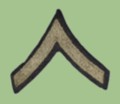 |
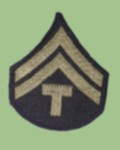 |
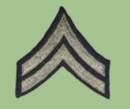 |
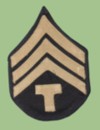 |
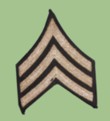 |
| Private First Class |
Tech Fifth Grade |
Corporal |
Tech Fourth Grade |
Sergeant |
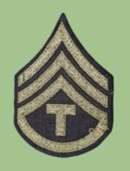 |
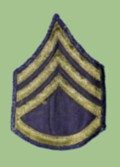 |
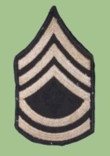 |
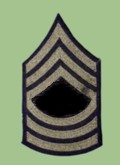 |
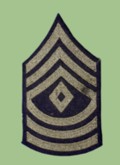 |
| Tech Third Grade |
Staff Segeant |
Technical Sergeant |
First Sergeant |
Master Sergeant |
MISCELLANEOUS PATCHES AND RIBBONS
In addition to the rank, unit, command, etc. patches. The US Army employed a series of miscellaneous patches to indicate
accomplishments completed by the soldier.
LEFT ARM
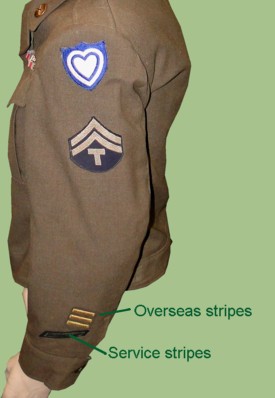
|
PLACEMENT OF PATCHES AND AWARDS ON THE UNIFORM
The order in which the miscellaneous awards are placed are as follows (from bottom to top): Meritorious Unit Citattion,
Service stripes, Overseas stripes.
The service stripe patch is placed approximately one inch abobe the top of the cuff. If no service stripe is earned the next
award achiebed is placed at the prescribed distance.
RIGHT SIDE
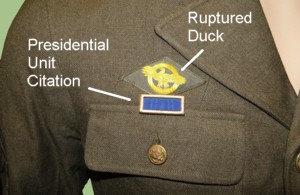
The Ruptured Duck patch is sewn one inch above the right pocket.
The Presidential Unit Citation is placed at the top of the right pocket.
|
The following table shows the mosst common miscellaneous patches used:
 |
 |
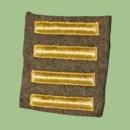 |
 |
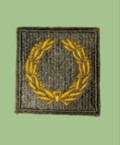 |
Honorable Discharge
This patch was issued to soldiers who sucessfully completed their tour of duty. The soldier was allowed to continue
wearing the uniform. Go into the base. but not access the classified areas.
|
Presidential Unit Citation
Is awarded to units of the United States Armed Forces, and those of allied countries, for extraordinary heroism in action against
an armed enemy on or after 7 December 1941.
|
Overseas Stripes
Each stripe indicates six months of service in a combat zone.
|
Service Stripes
Each stripe indicates three years of service.
|
Meritorious Unit Citation
Displays exceptionally meritorious conduct in the performance of outstanding service, heroic deeds, or valorous actions.
|
US ARMY AIR FORCE TECHNICIAN SPECIALIST PATCHES
There were five different technical specialties that an Army Air Force enlisted man could earn during WWII. A patch was given
for mastering each skill. Of dark Blue background with a yellow thread embroidered design. Triangular shape. cut-edge
construction.
RIGHT SIDE
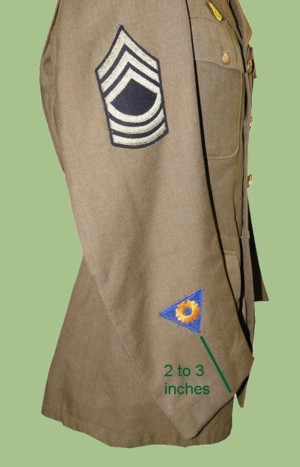
|
LOCATION OF PATCHES IN THE UNIFORM
The US Army Air Force technician specialist patch is attached to the bottom section of the right arm. It is placed approximately
two to three inches away from the end of the cuff.
|
 |
 |
 |
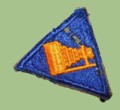 |
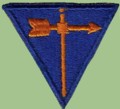 |
Armament
Initially worn by nine occupations which included aerial torpedo mechanic, anti-aircraft machine gunner, and bombsight mechanic.
|
Communications
This patch was initially worn by 22 occupations which include: radio operator, control tower operator, communications chief, cryptographer, All radio mechanics ( 6 different types), radio observer (3 types), telephone and telegraph lineman, and wire chief.
|
Engineering
Originally worn by 33 different occupations which include: airplane inspector, crew chief, line chief, flight chief, all mechanical airplane specialists,
depot engineer chief, parachute shop chief, parachutr rigger and repaiman, glider mechanic and welder.
|
Photography
This was worn by nine different occupations including; camera technician, photographic chief, photographic interpreter, photographic laboratory
chief, and motion picture cameraman.
|
Weather
This patch was worn by six different occupations which included; weather cryptographer, forecaster, observer, station chief, and radio sonde operator.
|
PATCH PLACEMENT ON THE UNIFORM
The following photos show where the Patches are placed on the WWII US Army enlisted man dress tunic ( known now
as the Class A uniform). The left and right directions are determined under the point of view of the person
wearing the uniform.
LEFT ARM
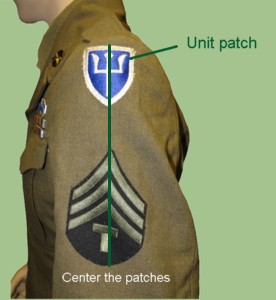
|
UNIT/COMMAND
The Unit, Army and Command patches are placed on the right arm. Near the top of the arm.
RANK
The rank patches are placed in both arms at about mid-point, above the elbow. Two to three
inches below the Unit / Command / Army patches.
|
RIGHT ARM
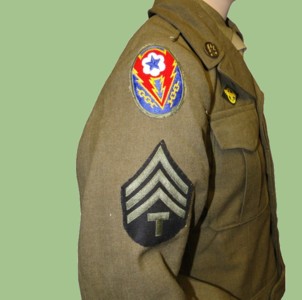
|
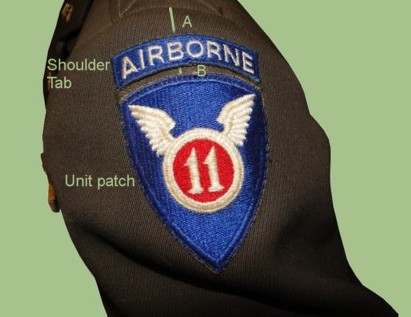 |
Placement of Unit patches on left shoulder of the uniform.
DISTANCE A: 1 Inch
DISTANCE B: 1/2 to 1 Inch
Shoulder tabs are centered between unit patach and shoulder seam. If no patch, 1 inch below
shoulder seam.
Unit patch 1/2 to 1 inch below shoulder seam and centered.
|
UNIT PATCHES - GENERAL COMMANDS
There were three General Commands controlling the United States armed forces during WWII. Each was an
autonomus component of the entire operation. One was in charge of air warfare. The other was in
charge of all ground forces. The last one encompassed six technical units.
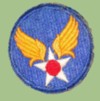 |
 |
 |
Army Air Forces
Active:
1941 - 9/18/1947
WWII Theater:
All
Obtain
|
Army Ground Force
Active:
1942 - 1948
WWII Theater:
All
Obtain
|
Services of Supply
Active:
1942 - 1946
WWII theater:
All
Obtain
|
UNIT PATCHES - THE FOUR ARMIES
The United States armed forces were divided into four different armies. They were labeled First army,
Second army, Third army and Fourth army.
 |
 |
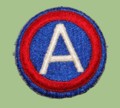 |
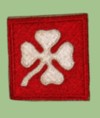 |
First Army
Active:
1918 - 1919
1932 - Present
WWII Theater:
West Europe, Normandy.
Obtain
|
Second Army
Active:
1918 - 1919
1933 - 1966
1983 - 1995
2014 - Present
WWII Theater:
USA
Obtain
|
Third Army
Active:
1918 - 1919
1932 - 1974
1982 - Present
WWII Theater:
Europe
Obtain
|
Fourth Army
Active:
1932 - 1971
WWII Theater:
USA
Obtain
|
UNIT PATCHES - ARMY CORPS
The structure of a field corps in the United States Army is not permanent; many of the units that it commands are allocated to it as needed on an ad hoc basis. On the battlefield, the corps is the highest level of the forces that is concerned with actually fighting and winning the war. Higher levels of command are concerned with administration rather than operations, at least under current doctrine. The corps provides operational direction for the forces under its command.
 |
 |
 |
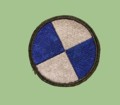 |
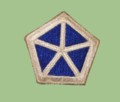 |
1st Corps
Active:
1918 - Present
WWII theater:
South Pacific
Obtain
|
2nd Corps
Active:
1 Aug 1940 - 10 Oct 1945
WWII Theater:
Europe and Africa
Obtain
|
3rd Corps
Active:
1918 - 1919
1927 - 1946
1951 - 1959
1961 - Present
WWII theater:
USA
Obtain
|
4th Corps
Active:
1918 - 1919
1939 - 1945
1958 - 1968
WWII Theater:
Europe
Obtain
|
5th Corps
Active:
1918 - 1919
1922 - 1924
1940 - 2013
WWII theater:
Europe
Obtain
|
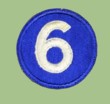 |
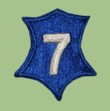 |
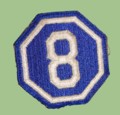 |
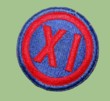 |
 |
6th Corps
Active:
1918 - 1919
1940 - 1946
1946 - 1950
1951 - 1953
1957 - 1962
WWII Theater:
Europe
Obtain
|
7th Corps
Active:
1918 - 1919
1921 - 1946
1950 - 1992
WWII Theater :
Europe, Normandy, Ardenes
Obtain
|
8th Corps
Active:
1918 - 1919
1940 - 1945
WWII Theater:
Europe, Normandy, Ardenes
Obtain
|
9th Corps
Active:
1940 - 1994
WWII Theater:
Pacific
Obtain
|
11th Corps
Active:
1942 - 1945
Theater:
Pacific
Obtain
|
UNIT PATCHES - DIVISIONS
After the civil war, patches were discontinued, but they appeared again during World War I, this time to stay.
One of the big problems that commanders were facing at the time was the ability to reassemble their troops after a
battle. The British came upon the idea of sewing a piece of colored cloth on the back of the jacket, just below
the neck. The idea was foe all the men wearing the same colored cloth to assemble under the nearest officer who
wore a like piece.
It was the American doughboy, however, who first wore a shoulder patch. This happened more or less by accident.
In the summer of 1918 the 81st (Wildcat) Division sewed a picture of a wildcat on their shoulder sleeves when
going through Hoboken on teh way to France. In France, General Pershing heard of this and ordered all the patches
to be taken off. Later he changes his mind and not only allowed the Wildcats to keep their shoulder patches but
required everyone to wear something similar.
 |
 |
 |
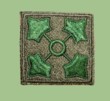 |
 |
| 1st Division |
2nd Division |
3rd Division |
4th Division |
5th Division |
 |
 |
 |
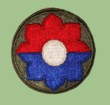 |
 |
| 6th Division |
7th Division |
8th Division |
9th Division |
26th Division |
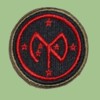 |
 |
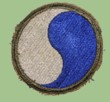 |
 |
 |
| 27th Division |
28th Division |
29th Division |
30th Division |
31st Division |
 |
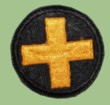 |
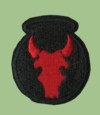 |
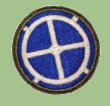 |
 |
| 32nd Division |
33rd Division |
34th Division |
35th Division |
36th Division |
 |
 |
 |
 |
 |
| 37th Division |
38th Division |
39th Division |
40th Division |
41st Division |
 |
 |
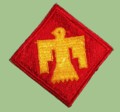 |
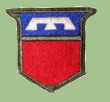 |
 |
| 43rd Division |
44th Division |
45th Division |
76th Division |
77th Division |
 |
 |
 |
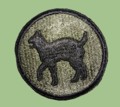 |
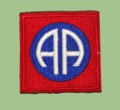 |
| 78th Division |
79th Division |
80th Division |
81st Division |
82nd Division |
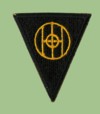 |
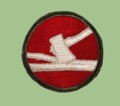 |
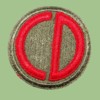 |
 |
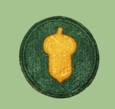 |
| 83rd Division |
84th Division |
85th Division |
86th Division |
87th Division |
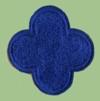 |
 |
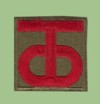 |
 |
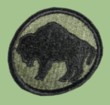 |
| 88th Division |
89th Division |
90th Division |
91st Division |
92nd Division |
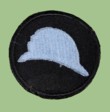 |
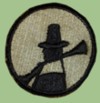 |
 |
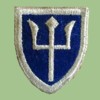 |
 |
| 93rd Division |
94th Division |
96th Division |
97th Division |
98th Division |
 |
 |
 |
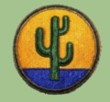 |
 |
| 99th Division |
100th Division |
102nd Division |
103rd Division |
104th Division |
 |
| Hawaiian Divisions |
|
The American tunics held a variety of patches
and insignia
in the left and right arms. Also in the breast area.
American uniforms were clearly marked with tags
which contained various information
regarding the manufacturing of the piece. These tags were found inside the front lower pocket,
inside the interior pocket or inside the sleeve. In many cases the tag has been removed
or it is no longer legible due to normal wear.
|
|
This page is a recognition and identification guide for WWII US military uniforms.
Multiple detailed photos of a specific sample are provided. Descriptions point out
clearly defined points that should be noted.
One of the most commonly asked questions is "How much is my WWII US uniform worth?".
A price guide is included here to address this question. The value of the uniforms is
reviewed over a period of several years. A trend can be observed. The present worth
of the American military uniforms in the collector's market is illustrated.
This service is provided free of charge to the visitor/enthusiast courtesy of
MilitaryItems.com,
a company dedicated to the preservation of military history and to providing quality
military antiques and collectibles to museums, institutions and the general public.
|
|
|
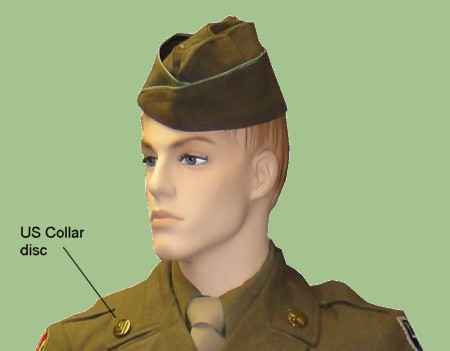
US ARMY ENLISTED MAN COLLAR INSIGNIA
All enlisted men who have completed basic training wear gold disc insignia bearing the block letters
U.S. and insignia of branch of the unit to which they are assigned. Basic trainees wear two U.S. insignia
until they complete basic training at which time the U.S. insignia worn on the left collar is replaced by
the appropriate branch insignia of the unit to which they are assigned, except as described below.
- Men assigned to headquarters or headquarter companies of divisions or higher units wear the insignia
of the branch which indicates their specific assignment.
- Enlisted personnel unassigned to branch wear the coat of arms of the United States on a 1-inch disc,
all of gold color metal.
- Men who are reassigned continue to wear the insignia of their former branch until they report for their
new assignment.
- Men assigned to medical units which are organic to TOE units of other branches wear the Army Medical
Service insignia. The U.S. insignia and insignia of branch are worn on the service coat, jacket and shirt
collar (when shirt is worn as an outer garment).
 |
 |
 |
 |
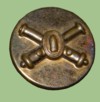 |
US Collar Disc
Indicates that the soldier belongs to the United States armed forces. As a general rule it was always placed on the right side lapel.
|
Army Air Corps |
Corps of Engineers |
Field Artillery |
Coastal Artillery |
 |
 |
 |
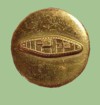 |
 |
| Cavalry |
Infantry |
Signal Corps |
Armored Force |
Ordenance Department |
 |
 |
 |
 |
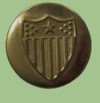 |
| Chemical Warfare Service |
QuarterMaster Corps |
Transportation Corps |
Medical Corps |
Adjutant General's Assistant |
 |
 |
 |
 |
 |
| Finance Department |
Judge Advocate General's Department |
Military Police |
WAACS |
Christian Chaplain |
 |
 |
|
|
|
| Jewish Chaplain |
Army Band |
|
|
|
RIGHT SIDE
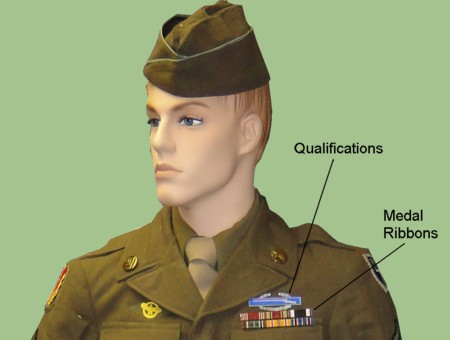 LEFT SIDE
LEFT SIDE
US ARMY QUALIFICATIONS, MEDALS AND AWARDS
The United States army issued different types of awards in order to recognize the diferent achievements of a soldier. Most
of the awards were placed on the left side of the uniform. Above the top pocket. Among the exceptions include the
Presidential Unit Citation. A table showing some of the awards follows.
 |
 |
 |
 |
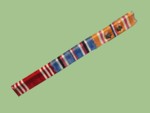 |
Expert Badge
To earn the qualificatin for pistol at the Combat Pistol Qualification Course, one must have a combined hit count of 26 out of 30.
|
Sharpshooter Badge
To earn the qualificatin for pistol at the Combat Pistol Qualification Course, one must have a combined hit count of 21 out of 30.
|
Marksman Badge
To earn the qualificatin for pistol at the Combat Pistol Qualification Course, one must have a combined hit count of 16 out of 30.
|
Combat Infantry Badge
The badge is awarded to infantrymen and Special Forces soldiers in the rank of Colonel and below, who personally fought in
active ground combat while assigned as members of either an infantry, ranger or Special Forces unit, of brigade size or smaller,
any time after 6 December 1941.
|
Medal Ribbons
The medal ribbons were worn, instead of the medal itself, because they took less space and avoided noise made by medals
hitting each other. The ribbons are displayed in order of importance. From right to left.
|
 |
Presidential Unit Citation
is awarded to units of the United States Armed Forces, and those of allied countries, for extraordinary heroism in action
against an armed enemy on or after 7 December 1941.
|
This US uniform is currently being reproduced.
It is becoming more difficult to be able to tell the fake ones from the real ones because
the quality of the reproductions is improving. The collector must become familiarized with
the construction style and materials employed in the manufacturing of this headgear.
Attention to the details is critical in order to be able to determine the authenticity of
the collectible.
If you have an interest is seeing other WWII American military uniforms, you can do so by
going to our WWII US Military uniforms
identification guide. Where we cover Army, Navy, Army Air Force and other organizations.
|







